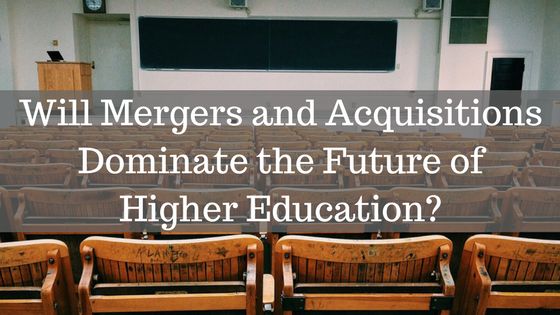
A hotly debated topic making the rounds in higher education now is whether American colleges and universities – public and private – face a round of mergers and acquisitions over the next several years.
There are a number of reasons that this topic had gained momentum.
Tuition discount rates are creating revenue squeeze for colleges
First, many colleges, especially small private colleges, are seeing their tuition discounts -- now at 50% on average for every tuition dollar received -- rise while their net tuition revenue remains flat or continues to fall. In fact, there are some colleges where the tuition discount now approaches 70 percent.
Many schools fail financial health test
Second, federal composite credit scores, which reflect the overall relative financial health of institutions along a scale from -1 to 3, have shown a good number of institutions to be in questionable financial health. A score greater than or equal to 1.5 indicates the institution is considered financially responsible. Colleges with scores of less than 1.5 but greater than or equal to 1.0 are considered financially responsible, but require additional oversight. These schools are subject to cash monitoring and other participation requirements.
The Chronicle of Higher Education reports that 177 degree-granting private colleges failed the U.S. Education Department’s financial-responsibility test, which seeks to quantify the financial health of proprietary and nonprofit institutions, for the 2014-15 academic year. That’s 18 more than failed the year before.
Further, of the 177 failing institutions, 112 (63%) are nonprofit and the rest are for-profit. For the previous year, 58 percent of the 159 failing institutions were nonprofit.
Third, Moody’s has revised its outlook for U.S. four-year higher education to stable from negative, reflecting the expectation that the sector's business environment will neither erode significantly nor improve materially in the next 12-18 months. Until this latest ratings change, higher education had received a negative rating since January 2013.
Moody’s rating suggests that higher education is at best treading water and not in a robust recovery from the impact of the Great Recession.
Fourth, there is growing anecdotal evidence of a struggle over financial health. Nearly four of ten private colleges reported that they still had available seats in their upcoming admissions class last year. On the public side, some states are considering closing or merging small and underperforming (often rural) campuses. The number of students entering community colleges is also dropping. Years of underfunding public sector institutions have produced problems like the collapsing infrastructure and structural deficit issues at respected institutions like UMass Boston.
In addition, much of the public discourse over projected closures like Sweet Briar College, failed merger attempts, and persistent rumors of financial distress continue to feed the higher education gossip circuit.
The cumulative effect is to pit trustees, staff, faculty, students, and alumni against one another as the blame game over failed efforts at transparency and worse indications of poor stewardship shake higher education’s foundations.
Free tuition at public schools could be detrimental to private institutions
The newest wrinkle addresses the likely impact that variations in the free public tuition proposals might have in the 35 states where such proposals have arisen. In New York, for example, a number of private college and university presidents with whom I have spoken recently wondered what will happen when the state uses the program to encourage New York State families to vote with their feet for four-year public colleges. The impact on the state’s private and community colleges could be detrimental, lasting and severe.
There’s little question that American higher education is now going through a period of chaos and uncertainty that is upsetting the otherwise glacial pace by which higher education has historically evolved.
But history also tells us that there have been at least two other periods characterized by the same level of disruption. In each case, higher education grew and adapted but did not suffer from an agonizing collapse. It is possible to imagine the possibility and to see the potential amidst the chaos, even if some of it is self-inflicted.
Disruption in higher education may spark creative, positive change
Perhaps this is ultimately the point. Higher education will need to change the way that it operates. Leadership at all levels must modernize and re-think financial models, operating principles, and governing structures. It is likely that American colleges and universities will not be able to rely on traditional state and federal partnerships in the way that they have in the past.
It is essential that institutions begin to imagine broad cooperative efforts that cut across rigid but now outmoded divisions as “public” and “private,” research and teaching, and two-, four-, and graduate-level institutions. Education must be a seamless, lifelong pathway.
The most important change will be to build an aggressive, unapologetic defense of what higher education represents, why what it does is important, and how its colleges and universities contribute in unique ways to American society.
Disruption makes anything possible. Now is the best time to think about how to manage this disruption rather than simply react to what’s coming.
This article first appeared on the Edvance Foundation blog.
